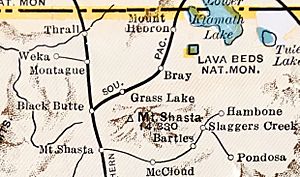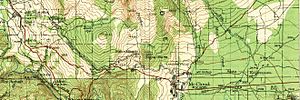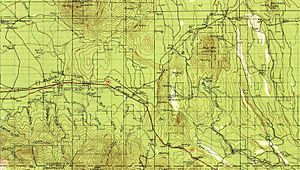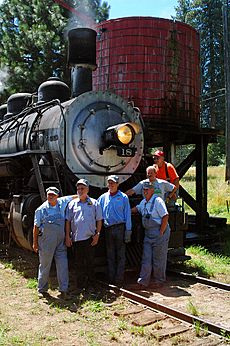McCloud Railway facts for kids
 |
|
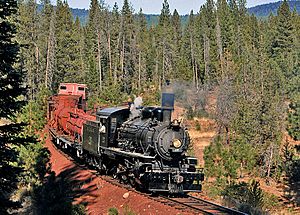
MCR No. 25, a 2-6-2 locomotive built by Alco in 1925. 2008 photo near McCloud.
|
|
| Overview | |
|---|---|
| Headquarters | McCloud, California |
| Reporting mark | MCR/MR |
| Locale | Mount Shasta, California |
| Dates of operation | 1897–2009 |
| Predecessor | McCloud River Railroad |
| Technical | |
| Track gauge | 4 ft 8 1⁄2 in (1,435 mm) |
The McCloud Railway (MCR) was a smaller railroad that operated near Mount Shasta, California. It started running trains on July 1, 1992. This happened when it took over from the McCloud River Railroad. The MCR company was officially formed on April 21, 1992.
The McCloud Railway carried goods and also offered fun passenger trips. One popular trip was the Shasta Sunset Dinner Train.
The trains mostly carried lumber and wood products away from the area. They also transported a special type of dirt called diatomaceous earth. In 1996, the railroad moved about 3,000 carloads of goods each year.
The McCloud Railway connected with other big railroads. It met the Union Pacific Railroad (which used to be Southern Pacific) in Mount Shasta, California. It also connected with the BNSF Railway (which used to be Burlington Northern) in Lookout, California.
On June 27, 2005, the railroad asked for permission to close down most of its lines. They wanted to stop using all tracks more than 3.3 miles (5.3 km) east of McCloud, California.
During 2009 and 2010, the Shasta Sunset Dinner Train was the only way the railroad made money. But because of a tough economic time called the Great Recession, the railroad closed in January 2010. They sold their last steam train, McCloud River Railroad #25, and most of their diesel trains. The railroad stayed closed but not officially abandoned for many years. After new managers took over in 2021, the railroad plans to reopen for storing empty railcars. It's not known how long the line will stay open for this.
Contents
The Railroad's Path
The railroad used about 95.5 miles (153.7 km) of track. Its main line went from Mount Shasta to Bartle. From Bartle, a section called the Burney Branch went south. The MCR also had a 19-mile (31 km) branch line from Bartle to Hambone, California. At Hambone, the BNSF Railway owned the track, but the McCloud River Railroad operated it. That line continued to Lookout Junction, where it met the Great Northern Railway (U.S.) mainline. This was just north of Bieber, California.
History of the McCloud Railway
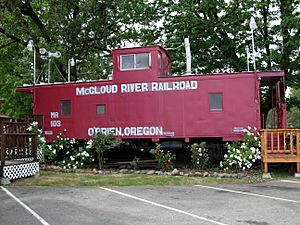
The McCloud Railway started as the McCloud River Railroad. It was created on January 22, 1897. Its main job was to carry logs from forests to a sawmill (a place where logs are cut into lumber). This sawmill was located on the Southern Pacific Railroad at a spot called Upton, near Mount Shasta, California.
At first, the railroad borrowed trains from the Southern Pacific. But in 1902, they got their very first own train, number 1. By 1901, the sawmill moved to McCloud. This made the distance for hauling lumber much shorter, only 17.8 miles (28.6 km). This happened because the connection point was moved south to Mount Shasta in 1906. In 1907, the trains started using oil fuel instead of wood. This was as the railroad expanded into forests east of McCloud. Trains brought logs to the McCloud sawmill from the east. They then carried finished lumber from the sawmill west to the Southern Pacific line.
In 1922, the Pacific Gas and Electric Company (PG&E) built new lines south from the McCloud main line at Bartle. They used these lines to build hydropower plants on the Pit River. Materials for building these power plants and dams were carried on the McCloud River Railroad.
Around this time, the McCloud Lumber Company, which owned the railroad, decided to build a new line northeast into more forests. Meanwhile, the Great Northern and Western Pacific Railroads were building a main line that went north to south. They planned to meet at Lookout, California. The McCloud decided to extend its lumber line to connect with these new big railroads. The connection was made at Lookout Junction in 1927. However, the Great Northern and Western Pacific actually met 6 miles (9.7 km) south in Bieber, Ca.
When the Great Depression hit, the McCloud company needed money badly. So, they sold the line from Lookout to Hambone to the Great Northern. The McCloud still had the right to operate trains on this line until it was closed in 2003. In 1955, McCloud extended the old PG&E line south to Burney, California. After reaching Burney, the McCloud railroad was about 130 miles (210 km) long. This included using 34 miles (55 km) of the Great Northern's Hambone branch.
The railroad mostly remained a logging railroad. It had several different owners over the years. These included U.S. Plywood Corporation (1963), Champion International (1972), and Itel Corporation (1977). On July 1, 1992, Jeff E. and Verline Forbis bought the railroad. On June 28, 2005, the railroad asked to close most of its lines. Service on all lines east of the McCloud Sawmill (which is now closed) has stopped. A small part of the line between McCloud, California, and Mount Shasta, California, stayed open for a short time for special trips and dinner trains. As the need for timber went down, the railroad slowly cut back its operations. New ownership also led to its decline. In 2009, the railroad was sold to MidWest Pacific Rail Net & Logistics. The railroad is currently closed but not officially abandoned.
Today, the railroad's tracks are not in good shape. Three trains remain in McCloud: the 36 (not working), the 38 (being fixed to run again), and the 30 (not working, bought back in 2008). The eastern part of the railroad has been turned into The Great Shasta Rail Trail, a path for walking and biking. However, BNSF has started rebuilding the eastern end of the Hambone Branch to store railcars. New ties and rails are waiting to be put down at Lookout. The western end will also be used for car storage, with train 38 being used for this. There is also talk of bringing back the old Shasta Sunset Dinner Cars.
The railroad also had regular passenger service for people until 1952.
The railroad's bridge over Lake Britton was used in a famous scene in the movie Stand by Me.
How the Railroad Operated
The first trains on the McCloud line carried logs to the sawmill. Passenger trains started in 1902. They traveled from Upton/Sission to Bartle, which was the end of the line then. The lumber company would rent the McCloud trains and keep them near the sawmills. When the Lookout Line was built, two trains would run to each connection point every day. This was in addition to the log and passenger trains. This schedule stayed the same until 1955, when the Burney Branch was built.
By this time, diesel trains were arriving. Two diesels were assigned to the Burney Branch. One would bring a train from McCloud to Burney. Another would exchange loaded and empty cars at Berry.
The McCloud Railway once tested a train called the ALCO Century 415. The company that made it suggested they buy three. The plan was to use two for the Burney route and one to move cars around the McCloud yard during the day. At night, two would go to Mount Shasta and one to Lookout. This was because logs were now mostly moved by trucks. Even though the C-415 wasn't bought, this schedule was used when the SD38 diesel trains were acquired. A fourth train was kept as a backup or for extra power.
When the McCloud Railway took over, they used a very similar schedule. The main difference was that one diesel train would pull a special excursion trip, sometimes with the steam engine #25. This was also true in the evening. Railroad operations slowed down in 2005 when the Burney Branch was closed. But operations continued. The Shasta Sunset Dinner Train was the only regular train on the entire line. There were only occasional short trips in the yard or on hills. When the Shasta Sunset Dinner Train stopped running in 2009, all railroad operations came to a halt. They have been on and off ever since.
Trains and Equipment
Lima Locomotive Works built two special steam trains called Shay locomotives for the McCloud River Railroad in February 1912. These trains were numbered 16 and 17. They were sold in 1924.
In the later years of steam trains, summer trains often had a "fire car" behind the engine. This was a tank car filled with water. It had a pump powered by a car engine. This was used to put out any fires that might start along the tracks.
Starting in 1948, the railroad began to buy Baldwin diesel trains. By 1964, they had 8 diesel trains. The railroad liked Baldwin's DRS-6-6-1500/AS-616 series because they were very powerful. They could pull much more than trains from other companies like ALCo or EMD at the time. In the late 1950s, when the Burney branch opened, the railroad bought two Baldwin RS-12 units, one Baldwin S-12, and one Baldwin S-8.
By the 1960s, the Baldwin diesel trains were almost twenty years old and starting to wear out. The railroad bought three used trains from Southern Pacific. These were an AS-616 and two DRS-6-6-1500s. Train #28 was damaged in a crash in the early 1960s. It was moved behind the repair shops and taken apart for spare parts. The AS-616 and one DRS-6-6-1500 were painted for the McCloud railroad. The second DRS-6-6-1500 was also taken apart for parts without being used. All the Baldwin trains were sold in 1969 to different scrap companies and smaller railroads. This happened when new trains arrived.
To replace the old Baldwin diesel trains, the railroad bought three EMD SD38 locomotives. They were numbered 36-38 and arrived in April 1969. These trains were used for all jobs along the line. As more goods needed to be moved, the railroad ordered a single EMD SD38-2 train. It was built in August 1974. When the railroad was put up for sale in 1998, Union Pacific Railroad was interested. Union Pacific bought the single SD38-2. This left the other three SD38s. The SD38s continued to work under the new owners. Interestingly, the first unit ordered, #36, had problems and was taken apart for parts in 2005. This was to keep the other two SD38s running, just like what happened with Baldwin #28. All three were later sold to the Dakota Southern Railroad.
Starting in 1995, the railroad also had two old steam trains from the McCloud River Railway, numbers 18 and 25. Train #18 was sold to the Virginia and Truckee Railroad in 2005.
Train No. 25, the steam engine that appeared in the movies Stand By Me and Bound for Glory, was not working from 2001 until September 2007. It was rebuilt for another movie deal, but that didn't happen. Train No. 25 was then stored in McCloud and was ready to run. Both No. 18 and No. 25 use oil for fuel. No. 18 made its first trip for money on the V&T on July 24, 2010. No. 25 was sold to the Oregon Coast Scenic Railroad in March 2011 for their special trips in Garibaldi, Oregon.
In 1994, the McCloud Railway rented an old McCloud steam engine (which was then Yreka Western #19). They painted it to look like McCloud River Railroad 19. This was done to see if people would be interested in a tourist train on the line. It was tested in April 1994. The test was a huge success! Special train trips for tourists started in the next two years.
The MCR once owned 1,182 freight cars in 1996. Most of these have been sold since the railroad stopped carrying goods.
Train Engines (Motive Power)
| Number | Builder | Type | Date | Works number | Notes |
|---|---|---|---|---|---|
| 1 | Baldwin Locomotive Works | 2-6-0 | 1891 | 11627 | Built for California Railway; bought 1897; later renumbered to McCloud #12 |
| 2 | Stearns Manufacturing Company | 3-truck Heisler locomotive | 1897 | Bought new | |
| 3 | Stearns Manufacturing Company | 3-truck Heisler locomotive | 1897 | Bought new | |
| 4 | Baldwin Locomotive Works | 2-6-2 | 1898 | 16239 | Bought new; scrapped in 1939 |
| 5 | Baldwin Locomotive Works | 0-6-0 Tank locomotive | 1900 | 17684 | Used to be connected to #6; sold after being separated. |
| 6 | Baldwin Locomotive Works | 0-6-0 Tank locomotive | 1900 | 17685 | Built as a double-ended train connected to #5; sold after being separated. |
| 7 | Baldwin Locomotive Works | 4-6-0 | 1886 | 7935 | Built for St. Louis–San Francisco Railway; bought 1900; sold to Hetch Hetchy Railroad in 1917 |
| 8 | Baldwin Locomotive Works | 2-6-2 | 1901 | 18595 | Bought new; sold to Amador Central Railroad |
| 9 | Baldwin Locomotive Works | 2-6-2 | 1901 | 18596 | Bought new; sold to Yreka Western Railroad |
| 10 | Baldwin Locomotive Works | 2-6-2 | 1901 | 18674 | Bought new; sold to Yreka Western Railroad |
| 11 | Baldwin Locomotive Works | 2-6-2 | 1904 | 23875 | Bought new; scrapped in 1939 |
| 12 | 2-6-0 | Used to be #1; scrapped in 1932 | |||
| 14 | Baldwin Locomotive Works | 2-8-2 | 1907 | 30850 | Bought new; scrapped |
| 15 | Baldwin Locomotive Works | 2-8-2 | 1907 | 30851 | Bought new; scrapped |
| 1st #16 | Lima Locomotive Works | 3-truck Shay locomotive | 1911 | 2401 | Bought new; sold in 1924 |
| 2nd #16 | Baldwin Locomotive Works | 2-8-2 | 1913 | 39394 | Bought from Silver Falls Timber Company |
| 1st #17 | Lima Locomotive Works | 3-truck Shay locomotive | 1911 | 2402 | Bought new; sold in 1924 |
| 2nd #17 | Baldwin Locomotive Works | 2-8-2 | 1916 | 42912 | Bought in 1942 |
| 18 | Baldwin Locomotive Works | 2-8-2 | 1914 | 41709 | Bought new; sold to Virginia and Truckee Railroad in 2005 |
| 19 | Baldwin Locomotive Works | 2-8-2 | 1915 | 42000 | Bought by McCloud River around 1924; sold to Yreka Western Railroad 1953. |
| 20 | Baldwin Locomotive Works | 2-6-2 | 1924 | 57617 | Bought new |
| 21 | Baldwin Locomotive Works | 2-6-2 | 1924 | 57618 | Bought new |
| 22 | American Locomotive Company (Schenectady) | 2-6-2 | 1925 | 66316 | Bought new |
| 23 | American Locomotive Company (Schenectady) | 2-6-2 | 1925 | 66317 | Bought new; sold to Arcata and Mad River Railroad #11 in 1953 |
| 24 | American Locomotive Company (Schenectady) | 2-6-2 | 1925 | 66434 | Bought new |
| 25 | American Locomotive Company (Schenectady) | 2-6-2 | 1925 | 66435 | Bought new; sold to Oregon Coast Scenic Railroad in March 2011 |
| 26 | American Locomotive Company (Brooks) | 2-8-2 | 1915 | 55492 | Bought from Copper River and Northwestern Railway in 1938 |
| 27 | American Locomotive Company (Brooks) | 2-8-2 | 1917 | 57291 | Bought from Copper River and Northwestern Railway in 1938 |
| 28 | Baldwin Locomotive Works | Baldwin DRS-6-6-1500 | 1948 | 73653 | Bought new, damaged, used for parts |
| 29 | Baldwin Locomotive Works | Baldwin DRS-6-6-1500 | 1950 | 74812 | Bought new; sold to Magma Arizona Railroad |
| 30 | Baldwin-Lima-Hamilton | Baldwin S-12 | 1953 | 75912 | Bought new. Sold in 1963. Repurchased by McCloud in 1995. |
| 31 | Baldwin-Lima-Hamilton | Baldwin S-8 | 1953 | 75913 | Bought new, built as an S-12 without a turbocharger |
| 32 | Baldwin-Lima-Hamilton | Baldwin RS-12 | 1955 | 76024 | Bought new; sold to California Western Railroad, scrapped 1995 |
| 33 | Baldwin-Lima-Hamilton | Baldwin RS-12 | 1955 | 76105 | Bought new; sold to California Western Railroad; now at Travel Town Museum |
| 34 | Baldwin-Lima-Hamilton | Baldwin AS-616 | 1952 | 75449 | Built as Southern Pacific #5253; bought 1963; sold in 1969 |
| 35 | Baldwin Locomotive Works | Baldwin DRS-6-6-1500 | 1949 | 74261 | Built as Southern Pacific #5207; bought 1964; sold in 1969 |
| 1st 36 | Baldwin Locomotive Works | Baldwin DRS-6-6-1500 | 1949 | 74258 | Built as Southern Pacific #5204; bought 1964; used for parts |
| 2nd 36 | Electro-Motive Diesel | EMD SD38 | 1969 | 34880 | Bought new, used for parts after electrical problems in 2005 |
| 37 | Electro-Motive Diesel | EMD SD38 | 1969 | 34881 | Bought new, sold to Dakota Southern Railway in 2017 |
| 38 | Electro-Motive Diesel | EMD SD38 | 1969 | 34882 | Bought new |
| 39 | Electro-Motive Diesel | EMD SD38-2 | 1974 | 74623-1 | Bought new; sold to Union Pacific Railroad, renumbered |
| 52 | Caterpillar Inc. | Passenger motor car | Built in Pondosa in 1923. Used to carry loggers; called the Red Goose |
Images for kids


